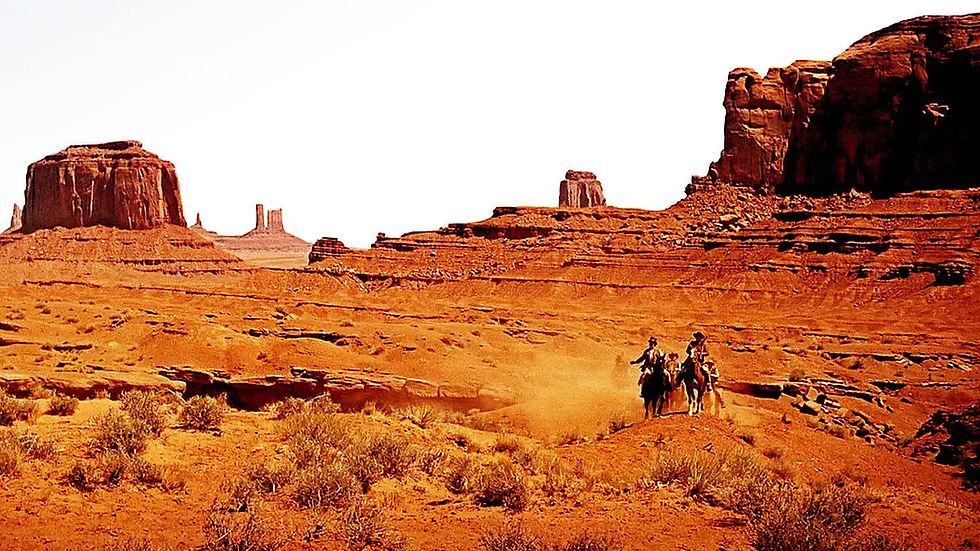捕鲸人之歌 | 风景与土地上的人类学记忆
- M

- Sep 25, 2020
- 7 min read
Updated: Jul 25, 2021

在介绍“景观与记忆”时,Simon Schama写道:“如果……我们的整个景观传统是共享文化的产物,出于同样的原因,它是由丰富的神话,记忆和迷恋所建立的传统” (Schama,14岁)。这种风景传统及其成分(神话,回忆和迷恋)在1963年的纪录片《鲸鱼,月亮和人(对于那些追随者)》中扮演着重要角色。
《鲸鱼,月球与人(针对那些将追随的人)》记载了一个岛上社区对暂时被遗弃的传统的振兴之情。 “角色”就像对传统本身的记忆一样痴迷于海豚狩猎。最终,神话,记忆和迷恋融合在一起,形成了感知岛和真实风景,并被称为Île-aux-Coudres。
宗教深刻地塑造了Île-aux-Coudres“当代”居民的文化和集体良知,这样做确实是神话。对于岛民来说,神话既是“无根据或错误的观念”,又是传统故事,用以“解释一种做法,信念或自然现象”。例如,据说收获的产量受人们庆祝中旬借贷的程度的影响:“长者说,当真的很喜庆的时候,就会有丰收。”在影片的开头,向观众介绍了有助于丰富景观特征的神话的“丰富财富”。这部纪录片充斥着社区中不同成员之间的对话,而这些交流中的第一个是在电影开始约五分钟后开始的。在一次公开拍卖中,两个人讨论了太空探索和月球问题,表达了对神话的信仰,这些神话据说可以解释天文物体的性质及其与地球的关系。例如,月球的减弱被解释为证据表明,满月后每天都有字面的“碎片”折断。一个人认为,“是月亮……创造了季节,产生了发束,繁殖了动物,并传播了世界。换句话说,她是地球的营养。这不只是一句话!几个世纪以来一直是真实的……自然界中的一切都在月亮的作用下进行。”在太空探索的初期(尤里·加加林在地球上飞行仅一年后拍摄),有人相信一个“高于(外层)太空”的领域有些人理解是可以理解的(正如一个人所声称的那样),但无可辩驳的是,有人认为月亮使地球肥沃,而“自然界中的一切都由它运作”。是的,月球仍未被人去探访,而且还掩盖了神秘色彩,但是,当时的天文学家肯定会发现岛民的说法令人怀疑且没有根据。这个人强调说,这些信念植根于可以追溯到几个世纪的传统,因此不应受到挑战。关于月球对地球影响的神秘信念源于传统,因此对岛民来说就像实物景观本身一样真实。 Île-aux-Coudres的风景既是自然力量塑造的自然景观,又是神话和民间传说塑造的具象景观。
即使是海豚狩猎的起源,对于那些实践它的人也充满了神话。电影中的几个“角色”在整个作品中相互呼应,声称海豚狩猎是“天才发明的”。一些人认为这个天才是土著人(在岛民看来是“野蛮人”),而另一些人则认为他是法国定居者。一个人自信地说,“海豚狩猎是野蛮人发明的”,而另一人则辩称“法国北部有海豚狩猎。这里的移民已经在法国这样做了。野人对此太懒了。”神话既是“解释一种实践,信念或自然现象”的传统故事,又是“无根据或错误的观念”。神话的第二种定义将土著人归类为土著人民“太懒惰”以至于无法发明一种捕鱼方法。一个人声称,关于狩猎传统起源的神话再加上一个事实:“当第一批殖民者到达时,堰痕就在那里了。我们知道的就这些。” “痕迹”一词出现在整个电影中,并与记忆紧密相连。
就像神话一样,记忆在纪录片中起着指导性的作用,并塑造着框架的风景。毕竟,这部电影是为了唤起人们对海豚狩猎的记忆而发起的(“ 1962年,这部电影的制作者向岛民们暗示,他们要恢复海豚的诱捕,从而更新了该岛特有的传统。”)他们通过探查社区长者的记忆来发现狩猎的方法和性质。整个岛上人们对岛民记忆的挖掘一直是主题。但是,记忆是通过堰的“痕迹”来实现的。堰的痕迹增添了该岛的纯粹性质,并且使历史/记忆真正可见。存在堰的痕迹可以唤起记忆:“在那儿,我们找到了堰的痕迹,这是通过祖先种植的树桩发现的。在秋天,堰仍然存在。在冬天,冰把沙子耙开,砸碎了木桩。但是树桩依然存在。”时间流逝,季节从一个移到另一个,但是像“树桩”一样,记忆仍然存在。有一次,“痕迹”成为记忆的代名词:当问亚历克西斯·特伦布莱时,“举行海豚狩猎活动会有任何好处吗?”他说,“优势在于保留踪迹。”特伦布莱大概不是在指文字痕迹。堰,但对狩猎传统及其在法兰西岛-库尔德人的生活中的无处不在的集体记忆。
In the introduction of “Landscape And Memory”, Simon Schama writes, “for if…our entire landscape tradition is the product of shared culture, it is by the same token a tradition built from a rich deposit of myths, memories, and obsessions” (Schama, 14). This landscape tradition and its constituents (myths, memories, and obsessions) play a prominent role in the 1963 documentary, “Of Whales, The Moon and Men (For Those Who Will Follow).”
Religion profoundly shapes the culture and collective conscience of Île-aux-Coudres’ “contemporary” inhabitants, but so to do myths. For the islanders myths appear as both “unfounded or false notions” and traditional stories employed to “explain a practice, belief, or natural phenomenon.” The harvest yield, for example, was said to be affected by the extent people celebrated mid-lent: “The elders said, when it got really festive, there’d be a good harvest.” The viewer is introduced to the “rich deposit” of myths that contribute to the landscape’s identity, early in the film. The documentary is replete with conversations between different members of the community and the first one of these exchanges begins about five minutes into the film. At a public auction two men discus space exploration and the moon, expressing a belief in myths that supposedly explain the nature of the astronomical body and its relationship to Earth. The waning of the moon, for example, is interpreted as evidence that literal “pieces” break off each day after a full moon. One man argues that, “it’s the moon that…creates the seasons and produces tress, and breeds animals, and propagates the world. In other words, she’s the Earth’s nourishment. It’s not just a saying! It’s been real for centuries…Everything in nature works by the moon.” In these early days of space exploration (filmed only a year after Yuri Gagarin orbited the Earth) it is somewhat understandable for someone to believe in a realm “higher than [outer] space” (as one man claims), but indefensible to contend that the moon fertilizes that earth and that “everything in nature works by” it. Yes, the moon was still unvisited and cloaked in mystery, but surely astronomers at the time would find the islander’s claims dubious and unsubstantiated. The man emphatically insists that these beliefs are rooted in a tradition that goes back centuries and therefore should not be challenged. The mystical belief of the moon’s influence over Earth is rooted in tradition and therefore is just as real to the islanders as the physical landscape itself. The landscape of Île-aux-Coudres is at once a physical one shaped by natural forces and a figurative one, shaped by myth and folklore.
Even the origins of porpoise hunting are entangled with myth for those who practice it. Several of the film’s “characters” echo each other throughout the work, claiming that porpoise hunting was “invented by a genius.” Some believe that this genius was an indigenous person (a “savage” according the islanders’), while other believe he was a French settler. One man confidently states that “porpoise hunting was invented by savages” whereas another contends that “there was porpoise hunting in the north of France. The immigrants here had already done it in France. Savages were far too lazy for that.” Myths stand as both traditional stories that “explain a practice, belief, or natural phenomenon” and as “an unfounded or false notion.” This second definition of myth categorizes the beleif that indigenous people “were far too lazy” to invent a method of fishing. Adding to the myth regarding the origins of the hunting tradition one man claims, “When the first colonists arrived the weir traces were there. That’s all we know.” The word “traces” appears throughout the film and is closely connected to memory.
Just like myth, memory plays a guiding role in the documentary and shapes the framed landscape. After all, the film was initiated to recall memories of the porpoise hunt (“In 1962 the makers of this film suggested to the islanders that they revive porpoise trapping and thus renew a tradition unique to the island.”) The film follows its character’s as they uncover, by probing the memories of the communities’ elders, the methods and nature of the hunt. This unearthing of the memories of the island’s people is a constant motif throughout the film. However, memory is made literal through the “traces” of the weir. The traces of the weir add to palimpsestic nature of the island and are literally history/memory made visible. The traces of the weir exist to conjure memory: “that’s where we found the traces of the weir, by the stumps that our ancestors had planted. In fall the weir’s still there. In winter, the ice rakes the sand and breaks the stakes. But the stumps remain.” Time passes, and seasons move from one to the next, but like the “stumps,” memory persists. At one point “traces” become synonymous with memory: when Alexis Tremblay is asked, ‘would there be any advantages to holding the porpoise hunt?’ he states that ‘the advantage is keeping traces.’ Tremblay is presumably not referring to the literal traces of the weir, but to the collective memory of the hunting tradition and its omnipresence in the lives of the people of Île-aux-Coudres.
“Of Whales, The Moon and Men (For Those Who Will Follow)” chronicles an island community’s revitalized obsession with a tradition temporally abandoned. The “characters” are just as obsessed with the act of porpoise hunting as they are with the memory of the tradition itself. Ultimately myth, memory, and obsession blend together, forming both the perceived and real landscape dubed Île-aux-Coudres.



Comentários